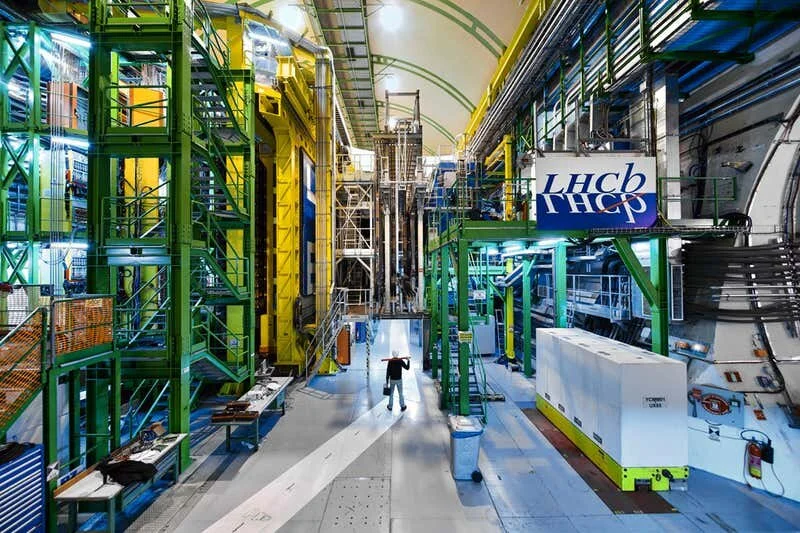Has the Large Hadron Collider finally challenged the laws of physics?
There has been a buzz of excitement surrounding what has been described as “tantalising hints of new physics” emanating from the LHCb experiment at the CERN particle physics lab, but just how excited should we be? In short: a little, but anyone holding their breath is in for an uncomfortable time.
LHCb is one of four big experiments at CERN’s Large Hadron Collider (LHC) near Geneva, Switzerland. As the “b” in the name indicates, it is intended to analyse decays of particles containing one of the six known flavours of quark, the “bottom” or alternatively “beauty” quark.
Bottom quarks are much heavier than the up and down quarks that make up protons and neutrons of conventional atomic matter, meaning particles containing them have lots of ways they can decay into lighter particles. Particles containing b quarks are also unusually long-lived, and these two properties combined make them very useful to physicists looking for physics beyond the standard model – our current best understanding of all particle interactions.
Particle physicists are desperate for any hints at expanding the standard model, which is supremely well tested but also woefully lacking, saying nothing about gravity, one of the four fundamental forces, or dark matter and dark energy, which seem to make up over 95 per cent of the cosmos.
Those are pretty key gaps, but when the standard model works, it really works, producing extremely precise predictions. LHCb seems to have found a deviation from these predictions in the rates at which a certain type of b-quark-containing particle, the B+, decays into the electron and its heavier cousin, the muon.
The standard model says that electrons and muons should be produced at roughly the same rate in these decays, but LHCb’s result suggests that they aren’t – and that is just the sort of hint of physics beyond the standard model that researchers are desperate to see.
Heady stuff. The fact is, though, that rumours of this anomaly have been around for a while – this one at LHCb for the best part of a decade. The news reports this week are based on a paper released by the collaboration that the anomaly has passed the “3-sigma” level of statistical significance, conventionally seen as the threshold for being “interesting” by particle physicists.
A 3-sigma result amounts to a probability of about 1 in 1000 that you would see a pattern of data like this if the standard model were correct. That might sound like a pretty solid indication that there’s something new here.
The problem is, however, that these sorts of decays are incredibly rare, and in looking for them physicists have to sift through a whole load of statistical noise, scanning widely. That leads to a seemingly paradoxical effect – the wider you cast your gaze, the more likely you are to see something that seems statistically significant. Gather more data, and these anomalies disappear again.
Particle physics is littered with 3-sigma effects that have come and gone, so researchers have settled on a much higher test threshold for discovery – “5-sigma”, corresponding to a probability of about 1 in 3.5 million that a pattern of data like this is a statistical fluke.
That is the bar the ATLAS and CMS experiments reached in 2012 with the Higgs boson – with the added security that two independent collaborations were seeing the same thing. LHCb has much further to go. Judging by the rate of data analysis – and the fact that the LHC has been switched off for an upgrade for the past two years – it is going to be a good while before they have anything more definite. Breathe out.
It is likely that this anomaly will fade away like the many others before it. On the other hand, if there is physics beyond the standard model accessible to like the LHC, our knowledge of it will start with an anomaly like this.
